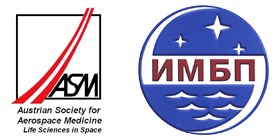An optimal immune function is an important requirement for the astronauts’ health and therewith for the execution of space flights. An intact immune system is of particular importance with regard to the close contact of astronauts in the space station and the limitations of medical provisions during long-term flights. Based on animal experiments and very few examinations on astronauts, it is known that sojourns in space and especially movement deprivation lead to limitations of the immune functions.
Objectives
Because the immune system represents a complex network where the immune cells and soluble factors (e.g. immunoglobulin, cytokine) co-operate in controlling and enhancing each other, the aim of the mentioned project is to record the highest number of immune parameters as possible. For this purpose, blood samples were organised and analysed in the ARC Research Seibersdorf laboratory before and after the cosmonauts’ sojourn in space. Different populations of white blood cells (lymphocytes), the activity of the so-called killer cells, the virus-infected cells and tumour cells recognize and make innocuous, and the amount of immunoglobulin in the blood were examined.
Apart from the tests, an examination about possible changes of the DNA structure through the conditions of the space flight was carried out. Therewith it would confirm if genetic damage that could lead to later damages occurs.
Results
Within the various lymphocyte populations it was shown – already like in the AUSTROMIR project – that stress conditions in general lead to a limitation of the number as well as the function of killer cells: The number and activity of killer cells fell during the cosmonauts’ pre-flight training. The immune system of the cosmonauts examined adapted after 439 days in space; the killer cells shown normal behaviour. The killer cells were clearly limited on re-entry after a 6-month sojourn of an additional cosmonaut.
The immune cells’ ability to DNA synthesis, and therewith the propagation, was only marginally changed in all cosmonauts examined after the flight. Propagated thread ruptures, i.e. DNA damage, were clearly detected within the DNA after the long sojourn in space.
The long-term sojourn in space lead to no significant immunoglobulin changes in the serum. In contrast, if the B cells, i.e. immune cells that are responsible for the production of immunoglobulin, are activated for immunoglobulin synthesis outside of the organism (= in vitro – in cell culture), they clearly produce less than before the flight.
Technical characteristics
For the experiment MIRGEN in the fore-front a developement of an own apparatur was not necessary.
For the taking of the blood-samples all needed medical and technical equipement were used as they are usable in every labor for blood examination and testing.
Experimenters
Dr. Helga Tuschl (project manager)
Dr. Elisabeth Weber
Rozika Kovac
all: Austrian Research Center Seibersdorf Ges.m.b.H., Seibersdorf
Dr. I. Konstantinova
Dr. M. Rykova
J. Antropowa
D. Meshkov
all: IMBP (Institute for Biomedical Problems), Moscow
